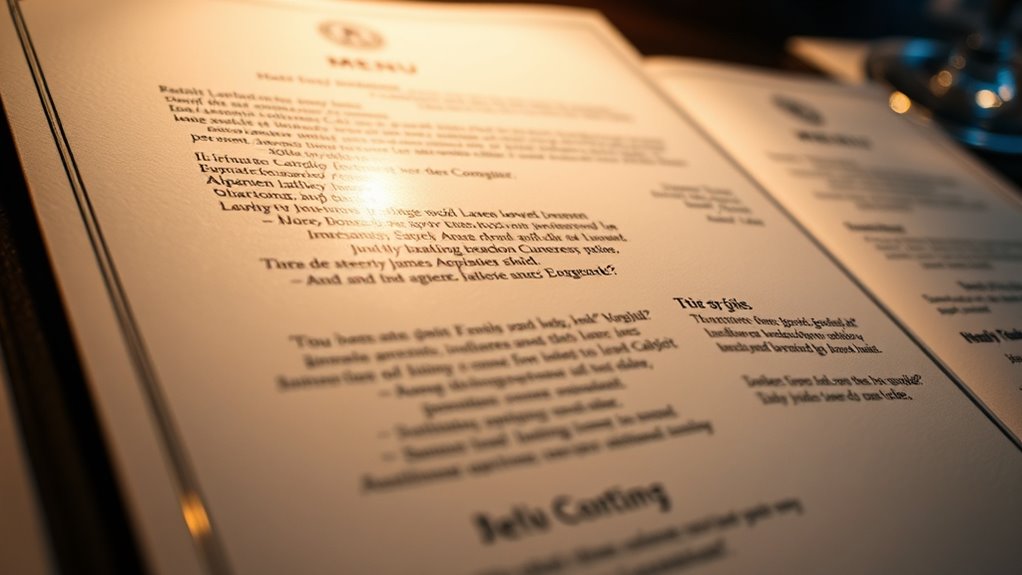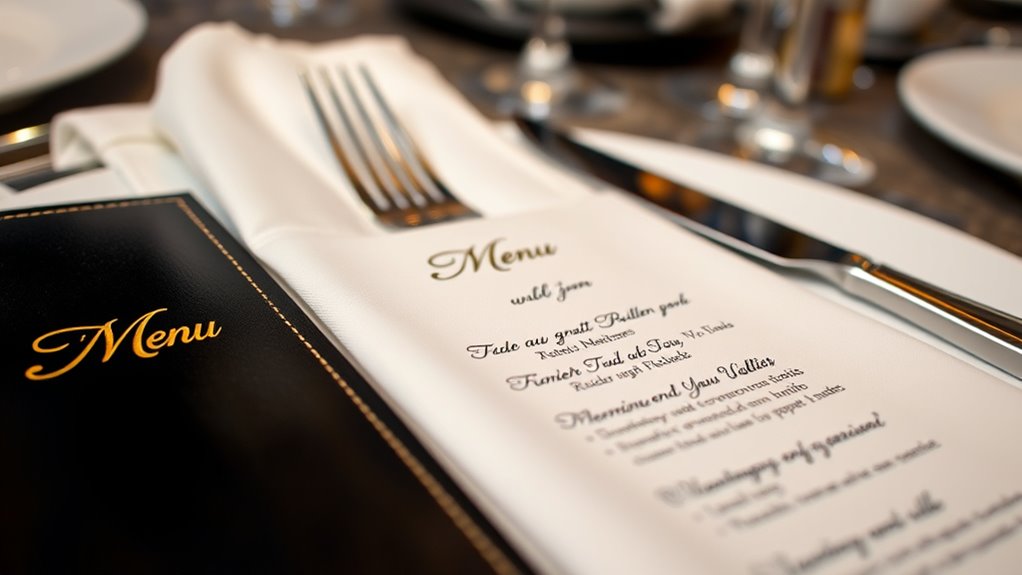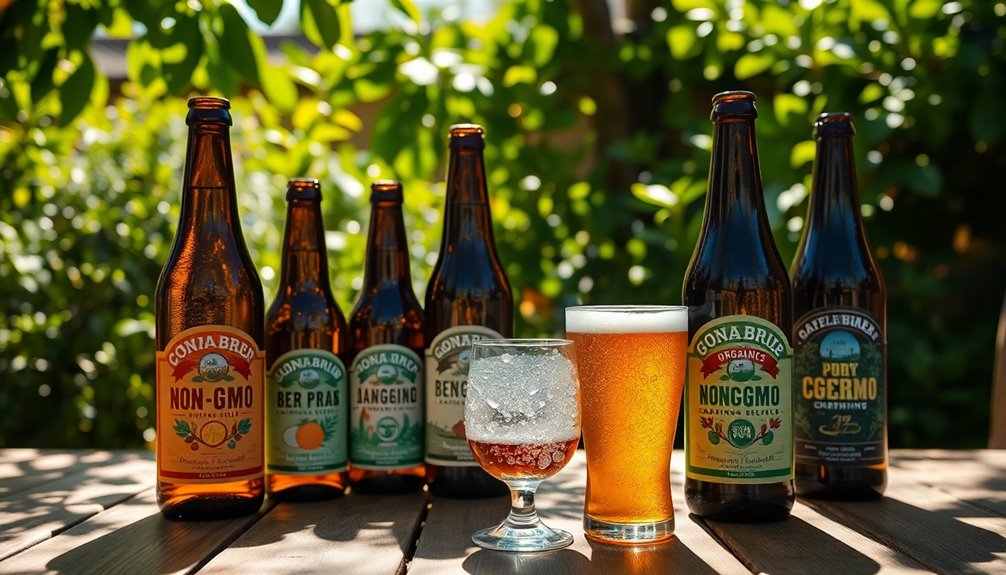Decoding a fine dining menu means understanding the fancy terms that describe presentation, ingredients, and cooking methods. Words like “plated,” “garnished,” or “en papillote” tell you how dishes look and taste. Recognizing plating techniques and wine pairings can elevate your experience. Knowing these terms helps you make confident choices and appreciate the chef’s artistry. If you continue exploring, you’ll discover even more about what makes each dish special and memorable.
Key Takeaways
- Familiarize yourself with culinary terminology related to presentation, ingredients, and preparation methods to better understand menu descriptions.
- Recognize plating techniques and garnishes to appreciate the artistry and visual appeal of dishes.
- Learn common cooking terms like “au gratin,” “sous-vide,” and “en papillote” to visualize preparation styles and flavors.
- Use wine pairing suggestions to enhance flavors and elevate the dining experience through complementary selections.
- Approach the menu as a culinary journey by understanding its structure and terminology for confident and informed choices.

Getting through a fine dining menu can feel overwhelming at first, but understanding its structure makes the experience more enjoyable. When you see a list of dishes with unfamiliar names and descriptions, it helps to recognize that many of these terms relate to presentation, ingredients, or how the food is prepared. For example, you might notice references to plating techniques, which describe the artistry behind how the dish is arranged on the plate. These techniques aren’t just for aesthetics—they influence how flavors are experienced together and can hint at the sophistication of the cuisine. Recognizing terms like “plating” or “garnished with” can give you clues about the dish’s visual appeal and texture, helping you anticipate what’s coming.
Understanding plating techniques reveals the artistry and enhances your appreciation of fine dining dishes.
Another key aspect to contemplate is wine pairings, which are often recommended alongside specific dishes. Wine pairings are carefully selected to complement the flavors of the food, enhancing both the wine and the dish itself. When you see a wine suggestion on the menu, it’s usually tailored to balance the richness, acidity, or spice of the meal. For instance, a buttery Chardonnay might accompany a creamy seafood dish, while a bold red could go well with a hearty steak. Paying attention to these pairings guides you in choosing drinks that elevate your dining experience, revealing how the right wine can make a subtle difference in taste.
Understanding the language on a fine dining menu also involves recognizing how dishes are described. Terms like “au gratin,” “sous-vide,” or “en papillote” refer to specific cooking methods that affect flavor and texture. “Au gratin” indicates a dish topped with cheese or breadcrumbs and baked until golden, while “sous-vide” means the food was cooked slowly in a vacuum-sealed bag for tenderness. “En papillote” refers to food cooked in parchment paper, trapping steam and flavors. Knowing these terms helps you imagine the dish’s preparation and taste, making it easier to select options aligned with your preferences. Additionally, understanding the structure of a menu can help you navigate the options more confidently and make informed choices.
Ultimately, decoding a fine dining menu is about more than just vocabulary; it’s about understanding the artistry behind each dish. Recognizing plating techniques and wine pairings enriches your appreciation of the chef’s craftsmanship and guides you to make more confident choices. When you’re familiar with these concepts, the menu becomes less intimidating, transforming your meal into an engaging culinary journey rather than a confusing list of unfamiliar words. So, the next time you face a fine dining menu, remember that each term offers insight into the chef’s intent and the experience awaiting you.
Frequently Asked Questions
How Should I Handle Dietary Restrictions When Ordering?
When handling dietary restrictions, you should be proactive and clear with the restaurant staff. Mention if you have gluten allergies or specific needs, like vegetarian options, and ask about ingredient details. Don’t hesitate to request modifications or replacements to guarantee your meal suits your restrictions. Being upfront helps you enjoy your dining experience safely and comfortably while respecting your dietary needs.
Are Tips Included in the Bill at Fine Dining Restaurants?
Like a secret handshake, tipping etiquette varies, but at fine dining restaurants, tips gratuity are often included. You should check the bill for a service charge, which sometimes covers gratuity, especially for larger groups. If no service charge appears, it’s customary to leave a tip of about 15-20%. Remember, your tip is a way to acknowledge excellent service, so adjust accordingly if the experience exceeds expectations.
What Is the Proper Attire for a Fine Dining Experience?
For a fine dining experience, you should dress to impress by following the dress code. Typically, men wear a suit or blazer with dress shoes, while women opt for elegant dresses or skirts paired with heels. Avoid casual attire like jeans, sneakers, or t-shirts. Dressing appropriately shows respect for the establishment and enhances your overall experience, ensuring you feel confident and comfortable during your exquisite meal.
How Do I Ask for Wine Pairings Without Feeling Awkward?
Think of asking for wine pairings as opening a door to a secret garden of flavors. When you speak, use wine vocabulary like “light-bodied,” “dry,” or “notes of citrus” to guide your server. Say, “I’d love a pairing that complements the seafood—what do you recommend?” This pairing language shows your interest and knowledge, making the conversation natural and enjoyable without feeling awkward, like a seasoned explorer.
What Etiquette Should I Follow When Dining Alone?
When dining alone, you should follow good table manners, like sitting up straight and keeping your phone silent. If you have restaurant reservations, arrive on time and politely inform the staff if you’re running late. Maintain a quiet, respectful demeanor and avoid unnecessary disruptions. Remember, good etiquette means being courteous to staff and other diners, which helps you enjoy your meal comfortably and confidently.
Conclusion
Now that you’ve decoded those fancy food terms, you can confidently order with ease and enjoy your meal more fully. Remember, many culinary words are just fancy descriptions for simple ingredients and techniques. Don’t let the jargon intimidate you—trust your palate and ask questions if needed. With a little knowledge, you’ll savor every bite and truly appreciate the artistry behind each dish. Bon appétit!










